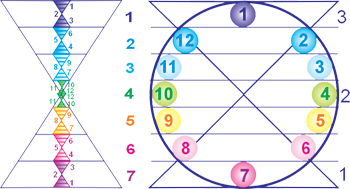Causal SYSTEMOLOGY

CAUSAL SYSTEMOLOGY: COMBINING GENERAL SYSTEM THEORY WITH THE UNIVERSAL LAWS OF DEVELOPMENT OF MULTI-LEVEL SPACE-TIME-ENERGY CONTINUUMS
Alexander Pelmenschikov,1,2 Alla Bolyanovskaya,2,3 Inna Shakhlevich,3 and Vitaly Polyakov31 Italian Academy of Management and Psychosystemology, Via Artigianato 2, 20061 Carugate, MI Italy, 2
Associazione per lo Studio dei Sistemi Italo-Russo (ASSIR), Via Artigianato 2, 20061, MI Italy, and 3International Scientific School of Universology, Prosp. Shokalskogo 29/2 87, 129221 Moscow, Russia With the aim to achieve the maximum universality and holism, Causal Systemology (CS) (V.Polyakov, 2001) integrates (i) the basic concepts of General System Theory with (ii) five general philosophical principles (duality, analogy, causality, periodicity, and alternativeness) within three sign-numerological models. These models represent the most universal space-time, space-energy, and time-energy aspects of hierarchic and synergetic cause-and-effect relations (the upper/lower triangle corresponds to the continuum of cause/effect). Transcending the "basic philosophical question”, CS also puts forward the principle of mutual causality of matter and consciousness.



Alexander Pelmenschikov,1,2 Alla Bolyanovskaya,2,3 Inna Shakhlevich,3 and Vitaly Polyakov31 Italian Academy of Management and Psychosystemology, Via Artigianato 2, 20061 Carugate, MI Italy, 2
Associazione per lo Studio dei Sistemi Italo-Russo (ASSIR), Via Artigianato 2, 20061, MI Italy, and 3International Scientific School of Universology, Prosp. Shokalskogo 29/2 87, 129221 Moscow, Russia With the aim to achieve the maximum universality and holism, Causal Systemology (CS) (V.Polyakov, 2001) integrates (i) the basic concepts of General System Theory with (ii) five general philosophical principles (duality, analogy, causality, periodicity, and alternativeness) within three sign-numerological models. These models represent the most universal space-time, space-energy, and time-energy aspects of hierarchic and synergetic cause-and-effect relations (the upper/lower triangle corresponds to the continuum of cause/effect). Transcending the "basic philosophical question”, CS also puts forward the principle of mutual causality of matter and consciousness.

model 1

model 2

model 3
CS considers mankind as one of the interconnected multilevel cosmic systems, with stable prosperity of whole human society and any its sub-system being primarily dependent on the harmonization of synergetic/hierarchic interactions at/between all the 7 levels of system relations in accordance with the "ideal vector of development” imposed by the cosmic super-system (3 superior levels not presented in the models (7+3=10)). For a social system the "ideal development” is defined by synthesizing these three models: 1) the model of "attractors” or purposeful orientations (model 1),2) the model of stage-by-stage development (model 2), and3) the model for prognostication of qualities and the most favorable way of development (model 3), which couples Pythagorean numerological matrix method with the Kelly’s method of repertory grid and allows to synchronize a system and all its sub-systems with the dominant rhythms of rotations of Earth around its axis and Sun. CS proposes systemic approaches to the global problem of renewal of all the aspects of human life: politics, economics, education, healthcare, etc. The corresponding projects are represented by different areas of Universology: Causal and Systemic Analysis, Prognostication and Diagnostics of Systems, Cardinal Psychology, Akmeological Psychofuturing, Integral Education, Social Systemology, Universal Management, etc. Polyakov, V. (2001). Universology (in Russian), VEVER, Minsk, Byelorussia.